Closely Related To Sharks But With Long, Flat Bodies And Wing-like Pectoral Fins, Mobula Rays are Ideally
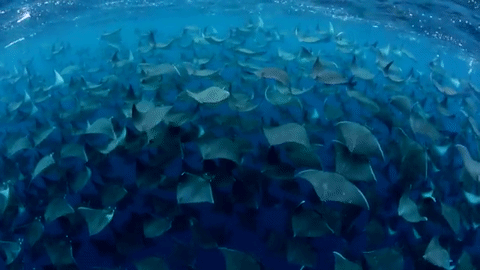
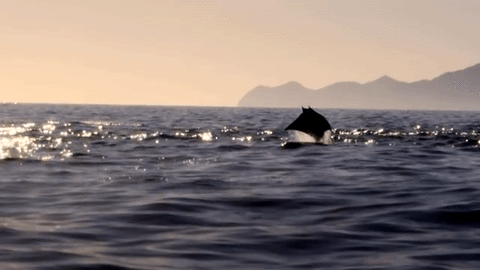
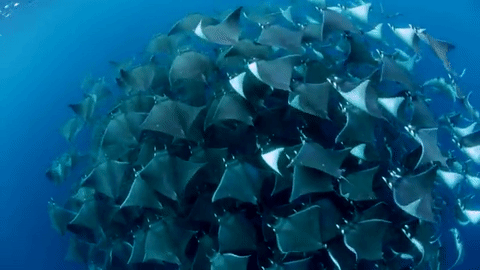

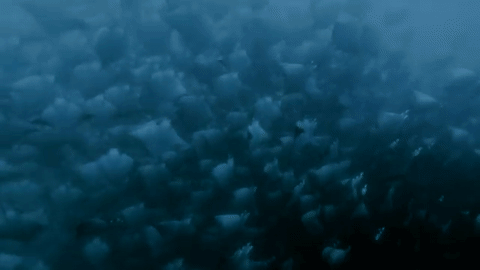
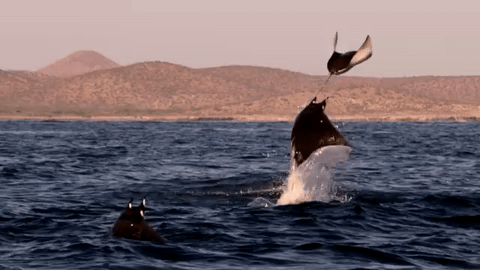
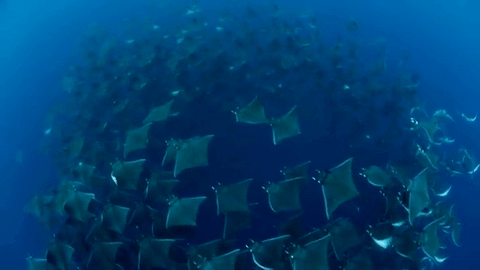
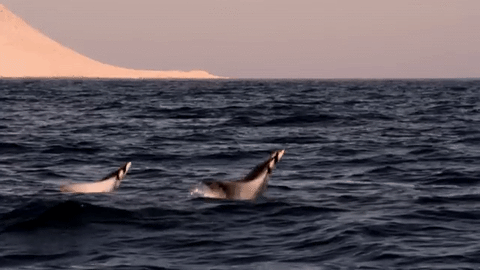
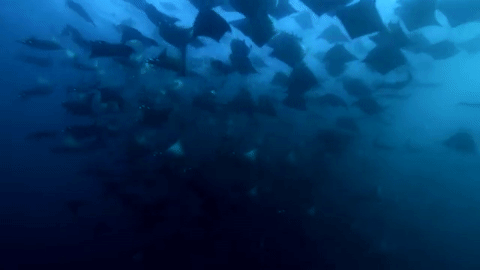
closely related to sharks but with long, flat bodies and wing-like pectoral fins, mobula rays are ideally suited to swooping through the water - here off the gulf of california - yet seem equally at home in the air, so much so that they have earned the name “flying rays”. mobula rays can reach heights of more than two metres, remaining airborne for several seconds.
mobula rays are quite elusive and difficult to study, so biologists are not quite sure why they jump out of the water. theories vary from a means of communication, to a mating ritual (though both males and females jump), or as a way to shed themselves of parasites. they could also be jumping as a way of better corralling their pray, as seen with them swimming in a circular formation.
what is known about mobula rays is that they reach sexual maturity late and their investment in their offspring is more akin to mammals than other fishes, usually producing just a single pup after long pregnancies, all of which makes them extremely vulnerable to commercial fishing, especially as a species that likes to come together in large groups.
More Posts from Hannahhaifisch and Others

Stretching SpaceTime
According to general relativity, the sun’s mass makes an imprint on the fabric of spacetime that keeps the planets in orbit. A neutron star leaves a greater mark. But a black hole is so dense that it creates a pit deep enough to prevent light from escaping.
Image credit: James Provost





Good wood - the slightly weird but rather wonderful ‘Art and Culture Production Centre’ in the remote fishing village of Kleivan in Norway, by the Scarcity & Creativity Studio, part of the Oslo School of Architecture and Design

Modular Origami Star by Maria Sinayskaya http://flic.kr/p/dJtry6

Hubble Image Captures Collision of Two Spiral Galaxies
http://www.sci-news.com/astronomy/hubble-collision-two-spiral-galaxies-04839.html

“Ratio of oscillations.” La méthode graphique dans les sciences expérimentales et principalement en physiologie et en médecine. 1885.

Native Gold with White Quartz
Eagle’s Nest Mine, Placer County, California

Quantum tunnelling
Tunneling is a quantum mechanical effect. A tunneling current occurs when electrons move through a barrier that they classically shouldn’t be able to move through. In classical terms, if you don’t have enough energy to move “over” a barrier, you won’t. However, in the quantum mechanical world, electrons have wavelike properties. These waves don’t end abruptly at a wall or barrier, but taper off quickly. If the barrier is thin enough, the probability function may extend into the next region, through the barrier! Because of the small probability of an electron being on the other side of the barrier, given enough electrons, some will indeed move through and appear on the other side. When an electron moves through the barrier in this fashion, it is called tunneling.

Quantum mechanics tells us that electrons have both wave and particle-like properties. Tunneling is an effect of the wavelike nature.

The top image shows us that when an electron (the wave) hits a barrier, the wave doesn’t abruptly end, but tapers off very quickly - exponentially. For a thick barrier, the wave doesn’t get past.
The bottom image shows the scenario if the barrier is quite thin (about a nanometer). Part of the wave does get through and therefore some electrons may appear on the other side of the barrier.
Because of the sharp decay of the probability function through the barrier, the number of electrons that will actually tunnel is very dependent upon the thickness of the barrier. The current through the barrier drops off exponentially with the barrier thickness
Source: nanoscience.com | Images: x | x | x

CGG POP-UP SHOW | May 13th 2015 | art space tetra | Fukuoka Japan
The Contemporary Guerilla Gallery Berlin is a project by a group of Berlin-based artists. The experimental project explores new ways of dealing with the contemporary art market. Part of the concept of CGG Berlin is independent art selling on eBay, another part is making pop-up exhibitions without external curatorial influence.
At art space tetra we show video works of five of the CGG artists. The video works have a documentary character and thematize the process of art production.
At the opening Hannah Reber and Gert-Jan Akerboom will be present and give a brief introduction of the project and answer questions after the screening.
The CGG Berlin pop-up at art space tetra shows works by:
Hannah Reber (www.hannahreber.de)
Gert-Jan Akerboom (www.gertjanakerboom.com)
Ortrun Stanzel (www.ortrunstanzel.de)
Ties Ten Bosch (www.tiestenbosch.com)
Inken Reinert (inken-reinert.de)
art space tetra
2-15 Susakimachi, Hakata Ward, Fukuoka, Fukuoka Prefecture 812-0028, Japan
http://www.as-tetra.info/archives/2015/150513065136.html#

-
 kechara-moon reblogged this · 1 month ago
kechara-moon reblogged this · 1 month ago -
 thejunkdrawers reblogged this · 2 months ago
thejunkdrawers reblogged this · 2 months ago -
 wearblacklikejohnnycash reblogged this · 4 months ago
wearblacklikejohnnycash reblogged this · 4 months ago -
 detefabulanarratur reblogged this · 4 months ago
detefabulanarratur reblogged this · 4 months ago -
 detefabulanarratur liked this · 4 months ago
detefabulanarratur liked this · 4 months ago -
 maxsevere reblogged this · 4 months ago
maxsevere reblogged this · 4 months ago -
 pasteleriasilvestre reblogged this · 4 months ago
pasteleriasilvestre reblogged this · 4 months ago -
 blukiwi reblogged this · 4 months ago
blukiwi reblogged this · 4 months ago -
 dewdropink liked this · 4 months ago
dewdropink liked this · 4 months ago -
 adelphoi liked this · 5 months ago
adelphoi liked this · 5 months ago -
 voiding-it-out reblogged this · 5 months ago
voiding-it-out reblogged this · 5 months ago -
 voiding-it-out liked this · 5 months ago
voiding-it-out liked this · 5 months ago -
 ghostly-light reblogged this · 5 months ago
ghostly-light reblogged this · 5 months ago -
 ghostly-light liked this · 5 months ago
ghostly-light liked this · 5 months ago -
 annita899gkdkizqh liked this · 6 months ago
annita899gkdkizqh liked this · 6 months ago -
 ever-so-nice reblogged this · 7 months ago
ever-so-nice reblogged this · 7 months ago -
 the-fisher-queen reblogged this · 7 months ago
the-fisher-queen reblogged this · 7 months ago -
 a-cosmonaut-or-an-astronaut liked this · 7 months ago
a-cosmonaut-or-an-astronaut liked this · 7 months ago -
 wanderingpanacea liked this · 8 months ago
wanderingpanacea liked this · 8 months ago -
 chryso-poeia liked this · 11 months ago
chryso-poeia liked this · 11 months ago -
 arcanescribbler reblogged this · 11 months ago
arcanescribbler reblogged this · 11 months ago -
 zehecatl reblogged this · 11 months ago
zehecatl reblogged this · 11 months ago -
 fantasticfilmfanatic-123 liked this · 11 months ago
fantasticfilmfanatic-123 liked this · 11 months ago -
 butterscotcheye reblogged this · 1 year ago
butterscotcheye reblogged this · 1 year ago -
 mummifiedraven liked this · 1 year ago
mummifiedraven liked this · 1 year ago -
 pardon-my-obsessive-tendencies reblogged this · 1 year ago
pardon-my-obsessive-tendencies reblogged this · 1 year ago -
 newmic reblogged this · 1 year ago
newmic reblogged this · 1 year ago -
 newmic reblogged this · 1 year ago
newmic reblogged this · 1 year ago -
 newmic liked this · 1 year ago
newmic liked this · 1 year ago -
 pangolin725 liked this · 1 year ago
pangolin725 liked this · 1 year ago -
 ahsoka-in-a-hood-2 reblogged this · 1 year ago
ahsoka-in-a-hood-2 reblogged this · 1 year ago -
 slimeyratbastard reblogged this · 1 year ago
slimeyratbastard reblogged this · 1 year ago -
 slimeyratbastard liked this · 1 year ago
slimeyratbastard liked this · 1 year ago -
 nukewar-san liked this · 1 year ago
nukewar-san liked this · 1 year ago -
 enhid-events liked this · 1 year ago
enhid-events liked this · 1 year ago -
 mx-lamour liked this · 1 year ago
mx-lamour liked this · 1 year ago -
 elephantkiss93 reblogged this · 1 year ago
elephantkiss93 reblogged this · 1 year ago -
 kuckucks-nest liked this · 1 year ago
kuckucks-nest liked this · 1 year ago -
 helle-bored reblogged this · 1 year ago
helle-bored reblogged this · 1 year ago -
 suplirachirea liked this · 1 year ago
suplirachirea liked this · 1 year ago -
 procaliscritiv liked this · 1 year ago
procaliscritiv liked this · 1 year ago -
 chinesekleptocracy liked this · 1 year ago
chinesekleptocracy liked this · 1 year ago